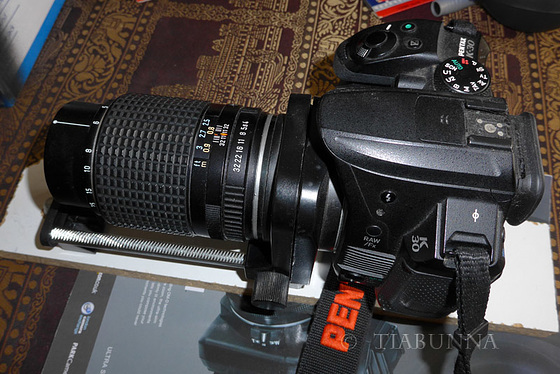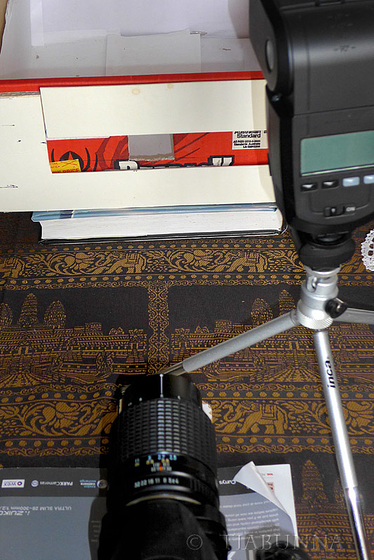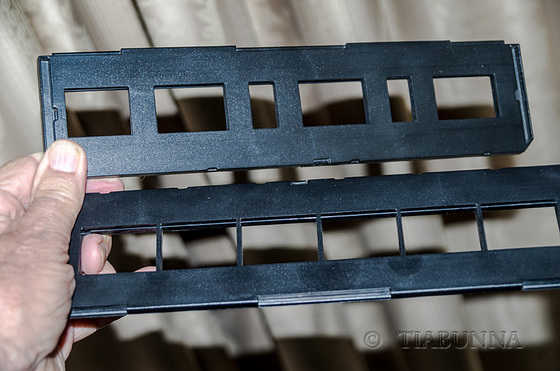Over the years I have owned a couple of dedicated slide/film scanners and, frankly, I was never totally satisfied with the results from them. One of the characteristics of the old slide film, particularly Kodak, was that it was fairly contrasty and high in saturation. The typical consumer-level scanner, in my experience, has real problems handling those darker more saturated areas because of a lack of dynamic range. The result is either "soot and whitewash with some colour" or electronic noise. I tried using specialised third party software and, although it helped, I still was less than satisfied with the results.
Finally the penny dropped for me. The commercial scanners rely on a sensor chip in the same way as our cameras, but the camera sensors are far more capable in terms of pixels and dynamic range. On that basis, why not use the camera to do the copying? Even more so when I already had a perfectly good macro lens. Using the camera also allowed the slide/film to be copied as a RAW file, with far greater scope for adjustment than would ever be possible with the JPG from a scanner.
I make no pretenses, my setup is quite crude and could easily be built with more refinement and quality. But that would take more time to build and needs to be appropriate to the volume of material for copying. The main thing is that, even at this rudimentary level of construction , the system works. Care to have a try?
I have found it useful to have a small LED torch inside the box, facing toward the slide/negative to provide back lighting to check for centring and focus with the camera. This need not be turned off when copying, as the light from the flash comfortably overwhelms it.
Finally, from experience, the most frustrating part of the process is to find grit on the output images when the copying is done. The processing time to remove these marks from just one image can easily take longer than it does to copy quite a few images - you will save an awful lot of cursing and time by cleaning the originals with a blower brush (though some grit always seems to remain).
I hope this proves interesting and helpful, I'll be interested to hear how you go should you try this approach.





7 comments
Peter Van Lom said:
I totally agree with your observation of the grit on the images. It was then that I found out that it was not only dust but also mold that had formed on the slides. Especially the slides that were 'behind' glass had the mold problem. And yes it takes a lot of time using the spot healing brush tool afterwards.
Just for documentation purposes I take pictures of (old) photos that are glued in photo albums. It is fast and good enough for documentation.
William Sutherland said:
beverley said:
but having used film for years ... we had nothing else ;-) I noticed when scanning pictures
always there was "dust" ... no amount of cleaning and being careful seemed to solve this
for me until someone said "photoshop" ... again too much for me to contemplate as I always
think you need a degree just to be able to get into photoshop ;-) ... (you know me) ... and
so I have photographed the originals and found that they have not turned out too badly ...
quick ... relatively easy and then within picmonkey I have been able to "smarten" them up
a little ... it has worked relatively well ... I have done this with my water colour paintings ...
especially the black and white zen type paintings ... it has not lost the texture of the
water colour paper ... not too much anyway ... and have again been pleased with the
results ... I have so many ... I dare not think, how many negatives ... what to do with them ?
;-) to be honest ... it would be fun to "play around" with a few ideas ... but alas ...
you know what ...? a woman's work is never done ... hehehe .... they remain in the draw ;-)
Roger (Grisly) said:
I have all the necessary bits and pieces it's just the time that becomes a problem but having read your interesting article I just have to give it a go sooner rather than later.
The comparisons will be interesting.
Gudrun said:
I started on my slides using a dedicated slide and negative scanner (Reflecta CrystalScan 7200) which has rather high quality but I met the same problems with dark areas when trying to lighten them up. With a bit of photoshopping they are quite O.K. though. I must admit I haven't continued scanning for quite a while now, I don't even know whether the scanner will work on my notebook;-) I doubt I'll get round to trying your method though RAW files would be a big plus.
beverley said:
on negatives making a kind of cardboard camera with the opening the size
of a negative ... (in a similar way as to making a pinhole camera) ... then once
he had set it all up ... he then used his camera to photograph the negative ...
then use some techniques on it to revert it to mono ... it was in a foreign
language as I recall ... and was not sure about trying to copy and paste
it here ... !!! but it was interesting to view ... a cardboard box ... a space
the size of a negative cut out ... even a cardboard roll ;-) tube small ...
cut with jagged edged one end ... like a xmas cracker when it has been
pulled ... this was stuck over the opening ... then the camera rested on
that .... he even made a long "slide" or paper ... folded over into four
long ways on .... the negatives were fed into this ... a strip of them ...
having cut out the size of a negative ... then he fed this through ;-)
all very difficult to explain ... but the end results seemed very interesting ...
follow that if you can .. hehehe ;-)
LutzP said: